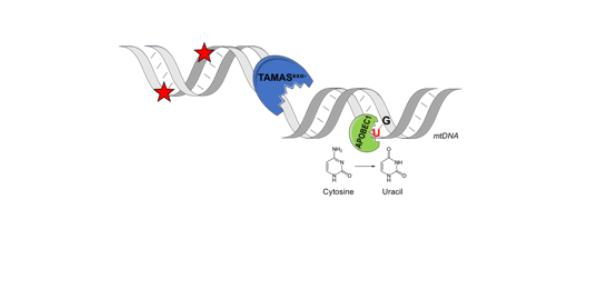
Submitted by Penny Peck on Thu, 25/07/2019 - 00:00
Stochastic mutations in the mitochondrial genome (mtDNA) have been linked to many diseases, and their accumulation has been proposed to act as a driving force in the ageing process itself. For the past 15 years the main animal model used to study this phenomenon has been the ‘mutator’ mouse, harbouring a proofreading defective mtDNA polymerase (POLG). These models accumulate high levels of mtDNA point mutations, but also large and small deletions and mtDNA depletion, causing progeroid (accelerated ageing) phenotypes.
The mutational heterogeneity that arises in the POLG model prompted us to develop an alternative mtDNA mutator model, exploiting the activity of the cytidine deaminase APOBEC1, which is published in Nature Communications.
Fruit flies (Drosophila melanogaster) expressing mitochondrially targeted APOBEC1 accumulate high levels of mtDNA point mutations, with no insertions/deletions or mtDNA depletion. In ‘mito-APOBEC1 flies’, the presence of multiple non-synonymous substitutions, even if at surprisingly modest heteroplasmy, disrupts mitochondrial function and dramatically impacts organismal lifespan and health.
A detailed comparison of the mutation profile of the mito-APOBEC1 and POLG models reveals that mutation type (quality) rather than quantity is a critical factor in impacting the fitness of flies. This study establishes the use of mito-APOBEC1 as a clean, potent model which exclusively induces point mutations.
It will be interesting to examine the effects of mito-APOBEC1 in other model systems and, being an inducible system, this also opens up the possibility to assess the effects of spatial and temporal inducation.
Andreazza, S., Samstag, C. L., Sanchez-Martinez, A., Ferndandez-Vizarra, E., Gomez-Duran, A., Lee, J. J., Tufi, R., Hipp, M. J., Schmidt, E. K., Nicholls, T. J., Gammage, P. A., Chinnery, P. F., Minczuk, M., Pallanck, L. J., Kennedy, S. & Whitworth, A. (2019) Mitochondrially-targeted APOBEC1 is a potent mtDNAmutator affecting mitochondrial function and organismal fitness in Drosophila. Nat. Comms. 10, 3280. doi:10.1038.s41467-019-10857-y

